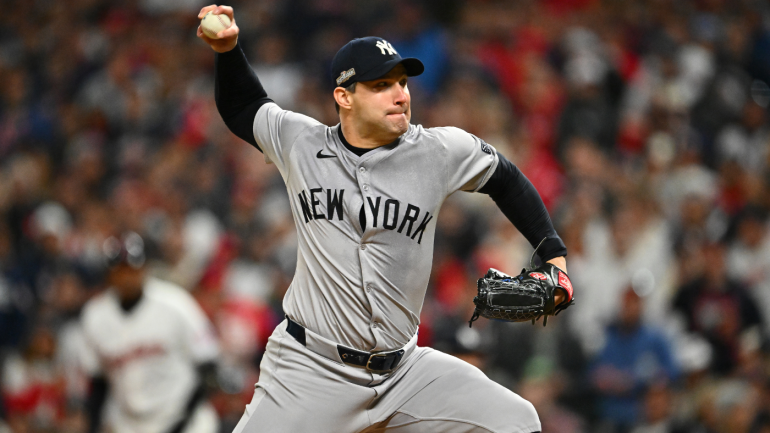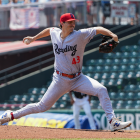
Why Yankees reliever Tommy Kahnle has thrown 56 straight changeups, and how one pitch is working so well
Kahnle, with a very limited arsenal, has been one of New York's best relievers this October

When it comes to the New York Yankees and noteworthy streaks, the number 56 is reserved for Joe DiMaggio, who notched a hit in 56 consecutive games during the 1941 season. Recently, though, a different Yankee has pieced together a different, if equally impressive sequence, with reliever Tommy Kahnle throwing 56 changeups in a row spanning across three-plus appearances this postseason. It's a streak he carries into World Series Game 3 vs. the Dodgers on Monday night.
Kahnle, 35, has not thrown a fastball or a breaking ball since the penultimate batter he faced during his appearance on Oct. 15 against the Cleveland Guardians. He's employed only his cambio against the 17 batters he's faced since, recording 3 1/3 innings while allowing one (unearned) run on a hit and three walks.
You probably have some questions about Kahnle's streak, including how he's been able to succeed without mixing up his approach. With that in mind, here are three things to know about Kahnle's recent changeup obsession.
1. How good is Kahnle's changeup?
Perhaps the answer is self-evident, given that Kahnle has generated fine results throughout this stretch, but for posterity's sake: his changeup is quite good.
During the regular season, Kahnle threw his changeup nearly three-fourths of the time. According to FanGraphs, only one other pitcher (minimum 20 innings on the year) threw even 50% changeups -- that being Trevor Richards, who split the season between the Toronto Blue Jays and the Minnesota Twins.
Tommy Kahnle, Filthy 88mph Changeup. 👌 pic.twitter.com/JU2qUejlEc
— Rob Friedman (@PitchingNinja) October 10, 2024
Despite an extreme amount of exposure to Kahnle's changeup, batters weren't able to solve its riddle.The opposition hit .157 with a .264 slugging percentage against it. Additionally, 38.9% of the swings taken on it resulted in a whiff.
To get a little more nerdy with it, FanGraphs computes run values for each pitch. Per their data, Kahnle's changeup was worth more than nine runs more than the average change, making it one of the 10 best in the majors. That checks out.
2. How does Kahnle's changeup work so well?
We've established that Kahnle's changeup is good, but not why that's so.
The answer is multi-faceted. From a movement perspective, the best changeups tend to resemble the pitcher's fastball, except with less velocity and more rise. That's intuitive: the more a pitcher can disguise his changeups as fastballs, the better the odds are that the opposing hitters will swing early and over the top of it.
The deception angle isn't just about movement, though; part of what makes a good changeup is a pitcher's ability to sell it with their delivery and arm action. Some pitchers will have noticeably reduced arm speed on their changeups versus the fastballs. Those hurlers don't trust their grip to do the work of creating separation from the fastball in velocity and movement. The best, however, do no such thing.
Tommy Kahnle, Jiffy Lube Special. 🛢️ pic.twitter.com/uTUD0hdzr3
— Rob Friedman (@PitchingNinja) September 12, 2024
You don't have to take our word for it. Here's a big-league skipper and longtime MLB player Aaron Boone saying essentially the same thing.
"It's just the arm action and the movement of the pitch. He's really over the top, so rips it, and the arm speed throws you off. It just doesn't quite get there," Yankees manager Aaron Boone told reporters before Game 2 of the World Series. "[For] the most part, if he executes his changeup where he wants in the strike zone or chase and gets the right movement on it, it's even -- obviously guys are looking for it, and it's still very hard to hit just because of the deception and the delivery and the arm speed."
3. What might end the streak?
Even if you're on board with Kahnle's changeup being one of the 10 best in the majors, and even if you can buy into the idea that opponents have a difficult time deducing that it's a changeup out of his hand, you might wonder: doesn't the law of diminishing returns come into play? At some point, don't pitchers have to present a different look?
Kahnle himself seems to agree with that thinking, telling MLB's Do-Hyoung Park: "Too many. Mix in a fastball, I guess?"
Without getting too far into the metaphysical weeds here, we think Kahnle's streak illuminates part of what makes pitching the most fun part of the game: it's a puzzle, with a seemingly infinite amount of variables that shape what can or cannot work.
The calculus differs for every pitcher based on, among other things, their usability. That's a fancy way of saying… well, how skilled the pitcher is at deploying any particular offering. If you've spent enough time around the game, you've undoubtedly seen pitchers who have a good breaking ball, but who have trouble locating it anywhere except in their chase area down and away. At some point, yes, they're going to have to give batters a reason to mind the zone, a reason to actually swing the bat. Otherwise, hitters will eventually learn to lay off that pitch and that'll be curtains for said pitcher.
Tommy Kahnle, Filthy Changeups. 👌👌 pic.twitter.com/QRRBugwVV5
— Rob Friedman (@PitchingNinja) September 6, 2024
In some cases, like Kahnle's execution matters a heck of a lot more than selection. That helps to explain some of the league-wide shifts we've seen over the past decade. Starters used to be required, as if by law, to have three or four pitches they could throw out there to keep batters honest. Nowadays, it's more common to see pitchers lean heavily on one or two offerings, provided they can maintain a high level of quality.
What works for Kahnle won't work for every pitcher. Indeed, we've had front-office types note that Kansas City Royals right-hander Seth Lugo, who has a kitchen sink of pitches that mostly grade as average or worse, could be a new model for teams seeking pitching bargains this winter. The idea being that those types could be undervalued given the league's current preference for top-heavy arsenals. But, much like an opponent's swing against Kahnle's changeup, we're getting out in front of ourselves.
For now, here's hoping that Kahnle can find his way into World Series Game 3 -- and that he continues to spam his changeup, testing traditional pitching logic all the while.


















